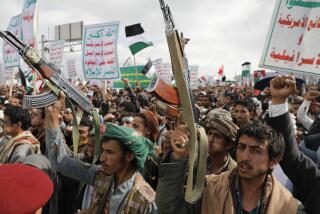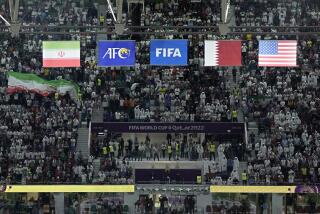Gulf State of Qatar Gets Stinger Missiles
- Share via
WASHINGTON — The Persian Gulf sheikdom of Qatar has secretly acquired 13 sophisticated Stinger anti-aircraft missiles, probably from Iran, in an apparent effort to match a U.S.-financed arms buildup by a rival border state, Bahrain, U.S. officials said Wednesday.
The missiles apparently are part of a CIA shipment of 20 Stingers that Iranian Revolutionary Guards seized in June, 1987, in a widely publicized raid on a convoy of U.S.-supplied Afghan rebels, said the officials, who asked not to be identified by name.
Qatar apparently bought the Stingers and a smaller number of launchers from Iran after the Iranians were unable to make them work. One official said that the missile launchers may lack special batteries required to fire them and that the Iranians may have duped Qatar into buying essentially useless weapons.
A second official speculated that the weapons came from other, still-undetected caches of Stingers that may have been stolen from American military stocks or smuggled out of Afghanistan.
An absolute determination of their origin is impossible until the weapons’ serial numbers can be obtained and traced, one source said.
It was unclear late Wednesday whether the United States will seek the return of the missiles. A State Department spokesman declined to comment on Qatar’s acquisition of the weapons.
In any case, the purchase adds weight to growing fears that the United States is losing control over its inventory of the highly accurate missiles, often called “the perfect terrorist weapon.”
Experts in Congress and elsewhere voiced serious concern last week that the CIA-supplied Afghan resistance will auction off its large stock of Stingers once an agreement is reached ending the guerrilla war inside Afghanistan.
Missiles for Bahrain
The United States has refused to sell Stingers to Qatar and the United Arab Emirates, another tiny oil-producing state on the gulf. Last December, however, Congress reluctantly agreed to sell about 70 missiles and 14 launchers to Bahrain, one of America’s closest Persian Gulf allies, under a foreign military sales program.
Bahrain has said that it needs the missiles to defend its oil terminals against attacks by Iran, which has hit nearby targets in its “tanker war” with Iraq. Qatar also cited the Iranian threat in seeking Stingers, but U.S. officials believe that the tiny sheikdom bought the missiles from Iran to counter what Qatar considers a military threat from its U.S.-supplied neighbor.
The Bahrain agreement has been sharply criticized by some members of Congress, who argue that the compact missiles are too deadly and too easily stolen to be entrusted to small states with poorly trained security forces.
The shoulder-launched Stinger homes in on the hot exhaust of jet aircraft, and some U.S. officials have warned that terrorists could use stolen Stingers to attack commercial jetliners. Others say that the threat is vastly exaggerated, noting that terrorists have had access to less sophisticated heat-seeking missiles for almost two decades.
U.S. worries about the spread of Stingers arose last summer after Iranian forces intercepted a convoy of Afghan rebel trucks, one of them carrying the missiles, after one truck broke down just inside Iran’s border.
One of the Stingers and launchers seized by Iran turned up last fall on an Iranian speedboat that was captured after it fired at Navy helicopter gunships in the Persian Gulf. The United States has not disclosed whether it has tracked the remaining missiles and launchers, but one U.S. official said most experts are certain the bulk of them are now in Qatar.
American experts became aware of Qatar’s black market purchase after pictures of the missiles turned up on a Qatar newsreel, one official said. Qatar defense officials reportedly have refused to tell U.S. officials where the missiles were acquired.
More to Read
Sign up for Essential California
The most important California stories and recommendations in your inbox every morning.
You may occasionally receive promotional content from the Los Angeles Times.














